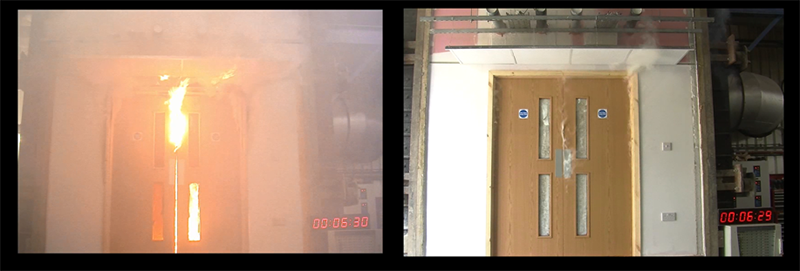Testing in action – The critical importance of effective passive fire protection

What drives the requirement for testing construction products?
Building regulations set the minimum standards for health and safety, convenience and accessibility. The guidance for meeting these requirements is set out in the Approved Documents, such as B, E, K, L1B, M, Q).
What is Passive Fire Protection?
Passive Fire Protection (PFP) has three main tasks to allow for protection of life and limited damage to property:
- restrict fire growth in early stages of fire
- contain the fire (compartmentation)
- protect the load-bearing structure
What is fire testing?
Using an example of a fire in a lounge, replicated with a crib in the corner of a container, Peter displayed the thermal image of the growth of the fire to the flashover point. Tracing the phases where energy radiates back into the room and anything combustible in that room heats up and becomes ablaze – flashover point – and into a fully developed fire.
How does this relate to testing we do on construction products?
Benchmark standards are designed to deal with each part of fire development.
Plotting time against temperature, a graph showed the early stage of the fire where ignitability is key, and materials are tested against that criteria. Likewise for the growth phase and fully developed phases, the points at which resistance to fire is measured.
Peter showed the 3 by 3m furnace at a testing centre where construction products were tested by being exposed to consistent conditions. While each fire has its own variables, standardised test conditions are crucial to determining that, for example, ’30 minutes fire resistant’ means the same for the product across the same type., i.e. a benchmark standard.
The fire resistance test report comprises:
- the test conditions
- construction details of the product
- the record of test data – surface temperatures, observations made, any deflection data
- test results in terms of minutes, e.g integrity of performance (the ability of fire to be contained) and insulation performance (measuring the temperature on the surface) and radiation performance (the limits of heat radiated)
The assessments made from the test results are considered by experts (UKAS) and form the considered opinion of a product.
“Assessments have a role to play but they have to be documents that are based on evidence, that are used by people that have experience in testing these construction products,” explained Peter.
Also supporting the performance of a product range, Peter mentions National Assessments, the PFPF guide to undertaking tech assessments, the requirement to follow EN 15725 principles and European classification and defined standards.
A product’s properties can easily be changed by unique environmental factors – for example, reducing the size of glazed opening, finishing off a veneer. Not every permutation of a product range can be tested but testing should be thorough enough to cover a range of design features.
“There’s no point in making something correctly if it’s installed incorrectly and pretty well, then not maintaining it correctly,” says Peter, “and it must be in line with the supporting evidence.”
Added insurance
Peter explained the added assurance that third party certification can bring. With first party verification, the manufacturers conduct tests and hand over the supporting evidence, leaving the installer a decision based on a degree of trust. Meanwhile, with third party certification, the manufacturers are asked what performances they would like to claim. Testers measure the end goal objectives against the test criteria.
Third party certification gives an extra layer of assurance because it looks at the products from the point at which the products pass through the production line and onto the factory floor. Therefore, the final labelling of that product gives valuable information in terms of provenance and traceability, invaluable for risk assessments.
The process doesn’t end there. There are repeat audits and audit testing, which gives a feedback loop. This is particularly useful when improvements have been made across a product range.
The tests in action
Peter then presented three tests: door-in-wall with stopping systems; door-in-screen assembly and fire stopping systems around cables.
In Test 1 both door sets were bought at the same time and were third party certified – the test made modifications by leaving out key component parts of what was to be the ‘bad’ door, e.g. intumescent strips and using safety laminate glass instead of fire safety glass and the ‘bad’ door was also missing firestopping at the back of the architrave. Meanwhile, the ‘good’ door had combined fire and smoke seals.
The smoke leakage and window damage on the ‘bad’ door was dramatic. With the ‘good’ door, it was hard to believe there was a raging fire behind it, save for the foam that the intumescent windows had released.

Test 1: A fire test from Warringtonfire – demonstrating the difference in passive fire protection effectiveness of a modified fire door (left) if key component parts removed
When the test ran to 13 minutes – reaching 800 degrees – it was too dangerous to continue with the ‘bad’ door, and it was deemed to have suffered ‘complete failure’.
Test 2 was the door-in-screen assembly. One of the sets was installed with a bad non-intumescent screen. Again, at the point where the bad model had failed (this was the 30-minute mark, by which time the windows had fallen out), it was hard to tell there was a fire behind it.
Test 3 involved individual cables and groups of cables that were either fixed with fire reactive material or with foam not designed for fire. Again, the results were clear – as clear as the daylight coming through the holes in the walls made by the destroyed foam.



